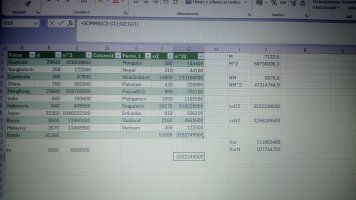First of all I'm sorry if i butcher some terms, English is not my language and statistics is far from it.
Let's say i have a N=14 with a variance of 2464,38 and a mean of 413,2 (i don't have any individual values, just the N; variance and mean).
Now i add another value, let's say 625,4.
How do i calculate the new mean and the new variance for N=15?
For the mean i guess it should be "413*14"=5782 ---- 5782+625=6407 ------ 6407/15= 427 (oldmean*oldN + newvalue) / newN
But what about the variance? I'm confused about it.
Let's say i have a N=14 with a variance of 2464,38 and a mean of 413,2 (i don't have any individual values, just the N; variance and mean).
Now i add another value, let's say 625,4.
How do i calculate the new mean and the new variance for N=15?
For the mean i guess it should be "413*14"=5782 ---- 5782+625=6407 ------ 6407/15= 427 (oldmean*oldN + newvalue) / newN
But what about the variance? I'm confused about it.


